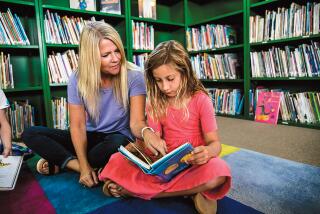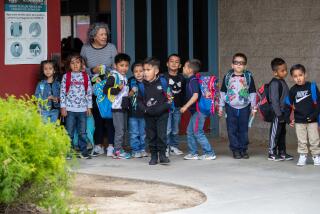Giving Children an Early Start on Reading
- Share via
Helping children get a head start on academic subjects can significantly boost their school careers.
And reading is the skill probably most worthy of early polishing.
In most public schools, students start learning to read at age 5 or 6. But before then, there’s a lot parents can do to help their child prepare.
First, set up a reading area at home. Include good lighting, chairs or floor pillows, and paper and crayons. Put your children’s books on low shelves or in stacks on the floor so they can reach them any time.
Recognition of letters is the first and most important skill to work on; most youngsters are ready for this about age 3.
There are many fun ways to practice naming letters. For example, the child can trace letters you have written, or use stencils. He or she can also shape them out of clay or cut them from white paper and color them.
Once the child has made a whole alphabet, post it in the reading area and from time to time ask him or her to name the letters.
Next, have your child practice phonics--the sounds that letters represent.
“Hooked on Phonics” and other packaged programs are popular but unnecessary, I believe.
It does just as well to point to letters and ask, for example, “What sound does B make?” and then, “Can you say a word that starts with B?”
After phonics, the child should be ready to learn sight vocabulary. That means learning to recognize entire words without having to sound them out first, increasing reading speed dramatically.
Start by teaching the child to recognize his or her name, usually the first word a child learns to spell.
Labeling frequently used objects around the home will help too. Let your child help you make the labels. After some practice, remove the labels, jumble them, then ask the child to put them back on the right things. It may take a few tries, but don’t let them get discouraged.
The concept of rhyming words is one that is quickly learned by most youngsters because it’s what makes their favorite nursery rhymes and songs so much fun.
Make a game of it by saying a word, then asking the child to name another word that rhymes. If his or her name is easy to rhyme, start there.
Sequencing of words is a crucial skill because words have to be in some kind of order to form sentences, and sentences must be properly sequenced in order to form paragraphs.
Ask the child to retell a favorite story in his or her own words. Teach him or her to follow directions by completing a step-by-step exercise or puzzle, or assembling a toy. Comprehension of printed material that is heard, not just read, is important too.
Play records or tapes of the child’s favorite stories, songs or nursery rhymes, then ask basic questions about them.
Creating one’s own written work is a fantastic final step because it makes the child incorporate all of the previous ones.
The child can do this even if he or she can’t write yet. Have the child dictate a letter to a favorite relative or friend, or an original story that you then staple together as a book.
Now the child has tangible proof of his or her learning.






